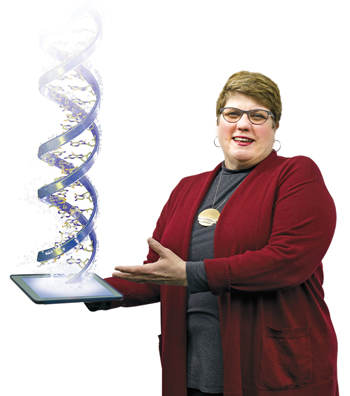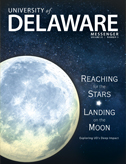Nurse, engineer, protector of biomedical knowledge
ALUMNI | It’s the “human response” piece that she always comes back to. Even now.
As the first woman and first nurse appointed to direct the U.S. National Library of Medicine (NLM)—a 181-year-old organization that predates the National Institutes of Health of which it is a part—Patricia Flatley Brennan, RN, PhD, HS75, often finds herself quoting the nursing definition she learned as a first-year student at UD.
“Nursing: the diagnosis and treatment of the human response to disease, disability and developmental challenges.”
The human response. How people react to the changes in their lives. How they find comfort and meaning and dignity. How they return to their normal, be it showering despite their open wound or attending poker night while still remembering to take their meds.

“The fundamental requirement we have of understanding health is to understand the person whose health we’re speaking of,” says Brennan.
It’s that uniquely nursing perspective that guides her as she manages biomedical knowledge. The future of data-powered health, as she calls it, is about reframing the notion of health itself and ensuring that the NLM has the necessary knowledge to create the health of the future.
“Healthcare, as all nurses know, is not a point interaction, but rather a process we enter into and step back from in the lives of our patients,” she says. “And yet all of our information and understanding is built on these tiny little lines that represent points of encounters with the care system where people come to us.”
Brennan wants to take the library to the place beyond, to “the care between the care”—those spaces between health care encounters where people live with their health problems and challenges, and where providers can learn how to better respond and deliver information.
Before joining the NLM, she had uncovered new ground already, from launching a mobile app so that children with chronic illnesses like cystic fibrosis could track their daily medication (while alerting their parents each time they do), to enhancing the ease and speed of data that must be easily retrieved.
At the NLM, Brennan oversees a staff of 1,700 women and men who manage data that can shed insight into many areas, including data that can help determine the exact genetic structure of a pathogen, so that when public health officials identify a food outbreak, they can sequence the gene and send it to the NLM for quick answers (like, hypothetically, whether it’s the same e. coli that appeared in California last week).
It’s a fitting role for Brennan, whose own research career has examined how to build technology in the service of patient care.
After working for years as a psychiatric nurse in the 1970s (those “days when patients would spend 12-14 hours in the OR, followed by three to five weeks in the ICU”), Brennan would earn her Ph.D. in industrial engineering and spend the next 30 years as an academic researcher at the University of Wisconsin-Madison. There, her interest in technology ranged from developing computer support groups for AIDS patients in the 1980s to more modern-day virtual reality simulations that examine the relationship between the home (layout, space, clutter) and its effect on self-managed patient care.
“She’s completely unafraid of learning curves,” says Junbo Son, her former engineering student in Wisconsin and a current business professor at UD.
As a doctoral student, Son worked with Brennan to develop advanced IT-enabled monitoring systems for healthcare companies and recalls how Brennan could listen to a company’s operation and know “automatically, intuitively” what problems they needed to solve.
“She’d just blow everyone away,” he says. “I think her curiosity is the source of all her energy.”
At 64, Brennan would likely agree. Outgoing, friendly and prone to loud, infectious laughter, she’d be the first to say her successes didn’t come from her studies. Of her 2.69 GPA, she unabashedly proclaims: “I had a great time at Delaware.” Still, she’s quick to credit her foundation at UD for preparing her for the successes of her career.
Calling the nursing program “well ahead of its time,” she says graduates left with a clear identity. “We didn’t struggle with ‘who are we, as nurses.’ We knew it.”
She knew then that the profession had everything to do with the human response to disease, disability and developmental challenges, just as that human response drives all that she does today.
As director of one of the federal government’s largest providers of digital content, dispatching more than 6,500 million bits of data per second, Brennan understands the need to reach people wherever they are, however she can. It’s a patriotic duty as much as a humanitarian one, given that two-thirds of the library’s users come from outside the United States and that the library itself contains information on many clinical trials across the globe.
“Almost everything we do for the country, we make open to the world,” she says. “Health and scientific knowledge know no country boundary, and we gain as much as we give.”




